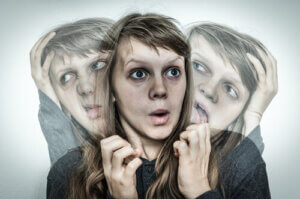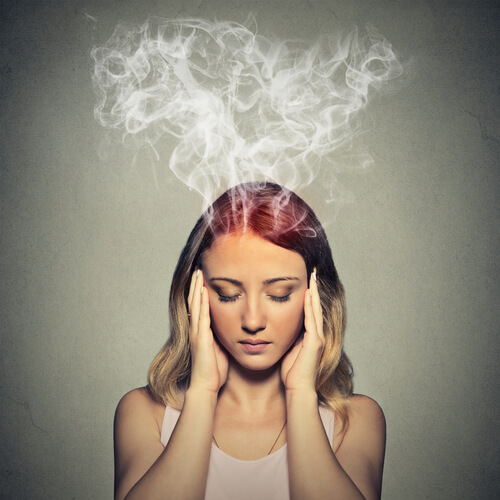The Symptoms, Causes, and Treatment of Schizophrenia


Escrito y verificado por el psicólogo Bernardo Peña
Schizophrenia is a mental illness that involves a serious alteration of psychological processes, the disintegration of the self, isolation, and a progressive withdrawal from reality. It’s a serious mental disorder that must be treated. Today, many of its causes are already known. Therefore, both the prognosis and the quality of life of the patients have experienced a notable improvement. Below, we’ll tell you more about the symptoms, causes, and treatment of schizophrenia.
Schizophrenia: The characteristics of this psychopathology
Schizophrenia is a serious and chronic mental disorder. It’s characterized by a course with three stages: The prodromal, the positive, and the negative phase.
- The promodal phase is characterized by a gradual withdrawal from reality. Little by little, the individual’s thoughts and behavior are getting stranger. People who live with the subject can become aware of the change. However, many times, when they occur over weeks, months, or years, they may not be entirely alarming.
- The phase of positive symptoms is the period in which the most prominent symptoms of the pathology are present. Hallucinations, delusions, and chaotic and disorganized behavior stand out above all. Obviously, both thought and language will be greatly affected.
- The negative symptom phase is characterized by isolation, self-stimulation, anhedonia, and amotivational syndrome.
The positive symptoms of schizophrenia
The positive symptoms involve:
- Delusions: Sustained false and incoherent thinking, despite evidence to the contrary.
- Hallucinations: Visual, auditory, tactile, kinesthetic, or sensory perceptions that occur in the absence of stimuli. For example, seeing something that’s not there or hearing voices that can’t be heard.
- Thought disorders: Thought doesn’t follow the laws of logic.
- Disorganized language: Here, a person’s language lacks sense altogether.
The negative symptoms of schizophrenia
The negative symptoms involve:
- Demotivation or an inability to carry out motivated behaviors
- The flattening of emotions
- Social isolation
- Anhedonia

Schizophrenia: Types and characteristics
This serious mental disorder has general similarities. However, there may be specific characteristics in each person. Schizophrenia is divided into the following types:
Paranoid schizophrenia
Paranoid schizophrenia is the most common of all types. It usually occurs in people over thirty years of age. It’s the type with the best prognosis and possibility of recovery. The symptoms are as follows:
- Auditory hallucinations.
- The presence of one or more delusions, generally involving persecution.
- Language, thinking, and behaviors are moderately affected.
Disorganized schizophrenia
This type of schizophrenia is the most serious and has the worst prognosis. In some cases, mechanical or psychopharmacological containment is required. Some of these symptoms occur:
- Hallucinations and severe delusions.
- Very disorganized language, thinking, and behavior.
- Emotions are very affected.
Catatonic schizophrenia
This type is characterized by its highly fluctuating evolution. Its symptoms are characterized, above all, by psychomotor impairment:
- The patient may remain immobile for several hours or, conversely, show excess motor activity.
- They resist carrying out certain movements.
- Mannerisms occur.
- The individual repeats phrases and words that don’t seem to make any sense.
Undifferentiated schizophrenia
This is one of the most common types of schizophrenia. It doesn’t fit into any of the above categories, hence its name. Although it has many characteristics, such as the presence of delusions and hallucinations, in terms of its thinking, language, and behavior it doesn’t meet the criteria of the other types.
Residual schizophrenia
This is another very common type of schizophrenia. It can occur in the transition between the positive and negative phases of schizophrenia. Although the person doesn’t have psychotic episodes, such as delusions and/or hallucinations, they do manifest anhedonia, demotivation, lack of expressiveness, and isolation.

The causes of schizophrenia
The etiology of schizophrenia is multicausal. Therefore, it must be approached under the biopsychosocial paradigm. Trying to explain it based on exclusively biological, psychological, or social reasons would be insufficient.
Following the vulnerability-stress model, predisposing and precipitating factors (biological and psychological) are needed to develop the disease. These, due to the action of triggering stimuli in the environment, such as stress or traumatic events, could give rise to this illness.
Biological causes
According to Moreno, AC (2007), several specific genes could be behind the development of schizophrenia. Therefore, its heritability is highlighted. However, the disease itself wouldn’t be inherited, but rather a vulnerability to suffering from it.
At the same time, it seems that the deregulated action of the neurotransmitter dopamine is also behind the initiation and maintenance of the disease. This is what’s known as the dopamine hypothesis. Finally, other researchers argue that schizophrenia is due to problems during childbirth or early viral infections.
Also read: Postpartum Depression: What Is it and Why Does it Appear?
Psychological causes
Among the psychological causes, we could find the presence of repressed childhood trauma. These could emerge into consciousness in the form of the symptoms of schizophrenia.
We can also highlight distorted thought patterns as psychological causes, which could give rise to distortions of reality, magical thinking, and various superstitions.
All of the above, along with poor emotional control, mood disorders, self-esteem problems, etc., can lead to a serious and complex mental illness such as schizophrenia.
Social causes
Members of ethnic and cultural minority groups are more likely to suffer from different types of psychosis. Perhaps, the members of these groups need to remain more vigilant in the face of a hostile reality.
There may be other factors, such as childhood sexual abuse and maltreatment, and dysfunctional communication patterns. Watzlawick, P., in 1976, called it the double-bind theory in family communication.
The treatment of schizophrenia
The treatment of schizophrenia has the following goals in mind:
- Eliminating the symptoms of the disease.
- Helping the patient to gain autonomy and control over their own life, that is, to set goals, take up personal projects, etc.
- Reinserting the patient into society, avoiding their institutionalization in health centers.
Therefore, the treatment of schizophrenia is based on:
- Pharmacotherapy: Antipsychotics are often prescribed to help prevent symptoms from occurring.
- Psychological therapy: In which the thoughts, emotions, and behaviors of the patient are worked on. This can take place in an individual or a group setting.
- Family therapy: Families are encouraged to reestablish family ties and promote healthy communication.
Final thoughts regarding the symptoms, causes, and treatment of schizophrenia
In conclusion, today, we’re learning more and more about schizophrenia. This has contributed to improving the quality of life of the people who suffer from it. However, research is still needed to develop increasingly effective treatments and to integrate these people into society sooner and under better conditions.
Schizophrenia is a mental illness that involves a serious alteration of psychological processes, the disintegration of the self, isolation, and a progressive withdrawal from reality. It’s a serious mental disorder that must be treated. Today, many of its causes are already known. Therefore, both the prognosis and the quality of life of the patients have experienced a notable improvement. Below, we’ll tell you more about the symptoms, causes, and treatment of schizophrenia.
Schizophrenia: The characteristics of this psychopathology
Schizophrenia is a serious and chronic mental disorder. It’s characterized by a course with three stages: The prodromal, the positive, and the negative phase.
- The promodal phase is characterized by a gradual withdrawal from reality. Little by little, the individual’s thoughts and behavior are getting stranger. People who live with the subject can become aware of the change. However, many times, when they occur over weeks, months, or years, they may not be entirely alarming.
- The phase of positive symptoms is the period in which the most prominent symptoms of the pathology are present. Hallucinations, delusions, and chaotic and disorganized behavior stand out above all. Obviously, both thought and language will be greatly affected.
- The negative symptom phase is characterized by isolation, self-stimulation, anhedonia, and amotivational syndrome.
The positive symptoms of schizophrenia
The positive symptoms involve:
- Delusions: Sustained false and incoherent thinking, despite evidence to the contrary.
- Hallucinations: Visual, auditory, tactile, kinesthetic, or sensory perceptions that occur in the absence of stimuli. For example, seeing something that’s not there or hearing voices that can’t be heard.
- Thought disorders: Thought doesn’t follow the laws of logic.
- Disorganized language: Here, a person’s language lacks sense altogether.
The negative symptoms of schizophrenia
The negative symptoms involve:
- Demotivation or an inability to carry out motivated behaviors
- The flattening of emotions
- Social isolation
- Anhedonia

Schizophrenia: Types and characteristics
This serious mental disorder has general similarities. However, there may be specific characteristics in each person. Schizophrenia is divided into the following types:
Paranoid schizophrenia
Paranoid schizophrenia is the most common of all types. It usually occurs in people over thirty years of age. It’s the type with the best prognosis and possibility of recovery. The symptoms are as follows:
- Auditory hallucinations.
- The presence of one or more delusions, generally involving persecution.
- Language, thinking, and behaviors are moderately affected.
Disorganized schizophrenia
This type of schizophrenia is the most serious and has the worst prognosis. In some cases, mechanical or psychopharmacological containment is required. Some of these symptoms occur:
- Hallucinations and severe delusions.
- Very disorganized language, thinking, and behavior.
- Emotions are very affected.
Catatonic schizophrenia
This type is characterized by its highly fluctuating evolution. Its symptoms are characterized, above all, by psychomotor impairment:
- The patient may remain immobile for several hours or, conversely, show excess motor activity.
- They resist carrying out certain movements.
- Mannerisms occur.
- The individual repeats phrases and words that don’t seem to make any sense.
Undifferentiated schizophrenia
This is one of the most common types of schizophrenia. It doesn’t fit into any of the above categories, hence its name. Although it has many characteristics, such as the presence of delusions and hallucinations, in terms of its thinking, language, and behavior it doesn’t meet the criteria of the other types.
Residual schizophrenia
This is another very common type of schizophrenia. It can occur in the transition between the positive and negative phases of schizophrenia. Although the person doesn’t have psychotic episodes, such as delusions and/or hallucinations, they do manifest anhedonia, demotivation, lack of expressiveness, and isolation.

The causes of schizophrenia
The etiology of schizophrenia is multicausal. Therefore, it must be approached under the biopsychosocial paradigm. Trying to explain it based on exclusively biological, psychological, or social reasons would be insufficient.
Following the vulnerability-stress model, predisposing and precipitating factors (biological and psychological) are needed to develop the disease. These, due to the action of triggering stimuli in the environment, such as stress or traumatic events, could give rise to this illness.
Biological causes
According to Moreno, AC (2007), several specific genes could be behind the development of schizophrenia. Therefore, its heritability is highlighted. However, the disease itself wouldn’t be inherited, but rather a vulnerability to suffering from it.
At the same time, it seems that the deregulated action of the neurotransmitter dopamine is also behind the initiation and maintenance of the disease. This is what’s known as the dopamine hypothesis. Finally, other researchers argue that schizophrenia is due to problems during childbirth or early viral infections.
Also read: Postpartum Depression: What Is it and Why Does it Appear?
Psychological causes
Among the psychological causes, we could find the presence of repressed childhood trauma. These could emerge into consciousness in the form of the symptoms of schizophrenia.
We can also highlight distorted thought patterns as psychological causes, which could give rise to distortions of reality, magical thinking, and various superstitions.
All of the above, along with poor emotional control, mood disorders, self-esteem problems, etc., can lead to a serious and complex mental illness such as schizophrenia.
Social causes
Members of ethnic and cultural minority groups are more likely to suffer from different types of psychosis. Perhaps, the members of these groups need to remain more vigilant in the face of a hostile reality.
There may be other factors, such as childhood sexual abuse and maltreatment, and dysfunctional communication patterns. Watzlawick, P., in 1976, called it the double-bind theory in family communication.
The treatment of schizophrenia
The treatment of schizophrenia has the following goals in mind:
- Eliminating the symptoms of the disease.
- Helping the patient to gain autonomy and control over their own life, that is, to set goals, take up personal projects, etc.
- Reinserting the patient into society, avoiding their institutionalization in health centers.
Therefore, the treatment of schizophrenia is based on:
- Pharmacotherapy: Antipsychotics are often prescribed to help prevent symptoms from occurring.
- Psychological therapy: In which the thoughts, emotions, and behaviors of the patient are worked on. This can take place in an individual or a group setting.
- Family therapy: Families are encouraged to reestablish family ties and promote healthy communication.
Final thoughts regarding the symptoms, causes, and treatment of schizophrenia
In conclusion, today, we’re learning more and more about schizophrenia. This has contributed to improving the quality of life of the people who suffer from it. However, research is still needed to develop increasingly effective treatments and to integrate these people into society sooner and under better conditions.
- Graff-Guerrero, A., Apiquian, R., Fresán, A., & García-Anaya, M. (2001). Perspectiva neurobiológica de la esquizofrenia. Salud Mental, 24(6), 36-42.
- Moreno, A. C. (2007). Las esquizofrenias: sus hechos y valores clínicos y terapéuticos. Elsevier España.
- Penn, D. L., & Mueser, K. T. (1995). Tratamiento cognitivo-conductual de la esquizofrenia. Psicología conductual, 3(1), 5-34.
- Reyes, M. M., Quiñonez, R. M., de Villalvilla, T. D., Lomba, P., Fernando, A. P., & Sosa, M. V. (2004). Transmisión familiar de los síntomas positivos y negativos en la esquizofrenia familiar y esporádica. Actas Españolas de Psiquiatría, 32, 353-357.
- Watzlawick, P. (1976). Teoría de la comunicación humana; interacciones, patologías y paradojas(No. 04; BF637. C45, W3 1976.).
Este texto se ofrece únicamente con propósitos informativos y no reemplaza la consulta con un profesional. Ante dudas, consulta a tu especialista.







